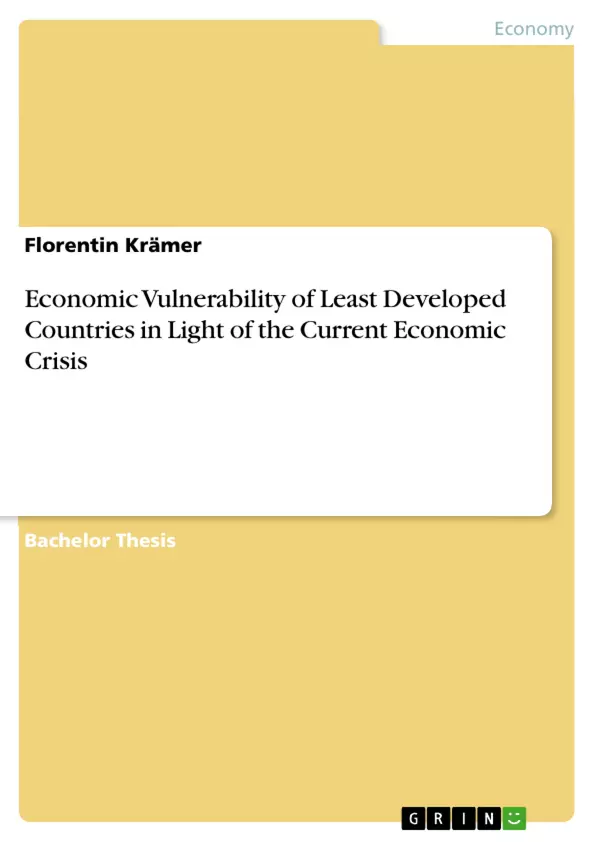As the economic crisis of the late 200os unfolds, the need for global political, regulatory and supervisory changes becomes apparent. This paper is intended to clarify the role that least developed countries play in this process. Different channels of vulnerability are identified and examined both in a dynamic and static framework, thereby contributing to an understanding of how and to which degree the world's poorest countries will be affected by the current global economic turmoil. It arrives at the conclusion that LDCs are likely to be negatively affected by numerous structural factors and identifies low and high vulnerability states by constructing a composite Economic Vulnerability Index.
Inhaltsverzeichnis (Table of Contents)
- Introduction
- Least Developed Countries
- Definition
- Structural Features
- The Economic Development from 2000 to 2007
- Decoupling or Convergence?
- The Economic Crisis of 2008
- Anatomy of the Subprime Mortgage Crisis
- Valuation Aspects and Asymmetric Information
- Adverse Selection between Individual Actors
- Moral Hazard between Individual Actors
- The Role of Banks
- Impact and Effects on the World Economy
- Impact on Developing Countries
- Direct Financial Channels
- Financial Openness
- Financial Institutions and the Real Economy
- Spillovers from the Global Recession
- Foreign Direct Investment
- Aid Flow Volatility
- Commodity Trading and Commodity Price Volatility
- Preliminary Conclusions
- Direct Financial Channels
- Economic Vulnerability
- Definition and Use
- Economic Approach
- Vulnerability in the Context of Political Science
- Review of Existing Indices
- Economic Characteristics of Small Size
- Discussion
- Construction of an Economic Vulnerability Index
- Cautionary Notice
- Methodology
- Indicators of Structural Vulnerability
- Exposure
- Population Size
- Location Index
- Shock Index
- Trade Shock Index
- Financial Shock Index
- Substitutability Index
- Merchandise Export Concentration
- Dependence on Strategic Imports
- Dynamic Examination of Vulnerability Indicators
- Financial Openness Index
- Terms of Trade
- Dependence on Strategic Imports Index
- Export Concentration Index
- Preliminary Conclusions
- Economic Vulnerability Index 2006
- Limitations of Indices
Zielsetzung und Themenschwerpunkte (Objectives and Key Themes)
This paper examines the vulnerability of Least Developed Countries (LDCs) to the economic crisis of the late 2000s. It aims to clarify the role of LDCs in the global economic crisis by identifying and analyzing different channels of vulnerability, both in a dynamic and static framework. The paper seeks to understand how and to what degree the world's poorest countries are affected by the current global economic turmoil.- The impact of the global economic crisis on LDCs
- The role of structural factors in determining LDC vulnerability
- The development of a composite Economic Vulnerability Index to identify low and high vulnerability states
- The dynamic examination of vulnerability indicators
- The limitations of economic vulnerability indices
Zusammenfassung der Kapitel (Chapter Summaries)
- Introduction: This chapter introduces the topic of the paper, highlighting the need for global political, regulatory, and supervisory changes in light of the economic crisis. It emphasizes the importance of understanding the vulnerability of LDCs to this crisis.
- Least Developed Countries: This chapter defines LDCs and outlines their structural features. It provides a background understanding of the economic context of these countries.
- The Economic Development from 2000 to 2007: This chapter examines the economic development of LDCs in the period leading up to the global economic crisis, discussing concepts like decoupling and convergence.
- The Economic Crisis of 2008: This chapter analyzes the causes and consequences of the economic crisis, focusing on the subprime mortgage crisis, valuation aspects, and asymmetric information. It also explores the impact of the crisis on the world economy and developing countries.
- Economic Vulnerability: This chapter defines economic vulnerability, reviews existing indices, and outlines the methodology for constructing a composite Economic Vulnerability Index. It examines various vulnerability indicators, both static and dynamic, to assess the vulnerability of LDCs.
Schlüsselwörter (Keywords)
This paper focuses on the economic vulnerability of Least Developed Countries (LDCs) in the context of the global economic crisis. The primary focus is on identifying and analyzing different channels of vulnerability, both in a dynamic and static framework. The paper utilizes a composite Economic Vulnerability Index to assess the vulnerability of LDCs and examines key indicators such as financial openness, terms of trade, dependence on strategic imports, and export concentration. - Definition and Use
- Quote paper
- Florentin Krämer (Author), 2009, Economic Vulnerability of Least Developed Countries in Light of the Current Economic Crisis, Munich, GRIN Verlag, https://www.grin.com/document/147251



